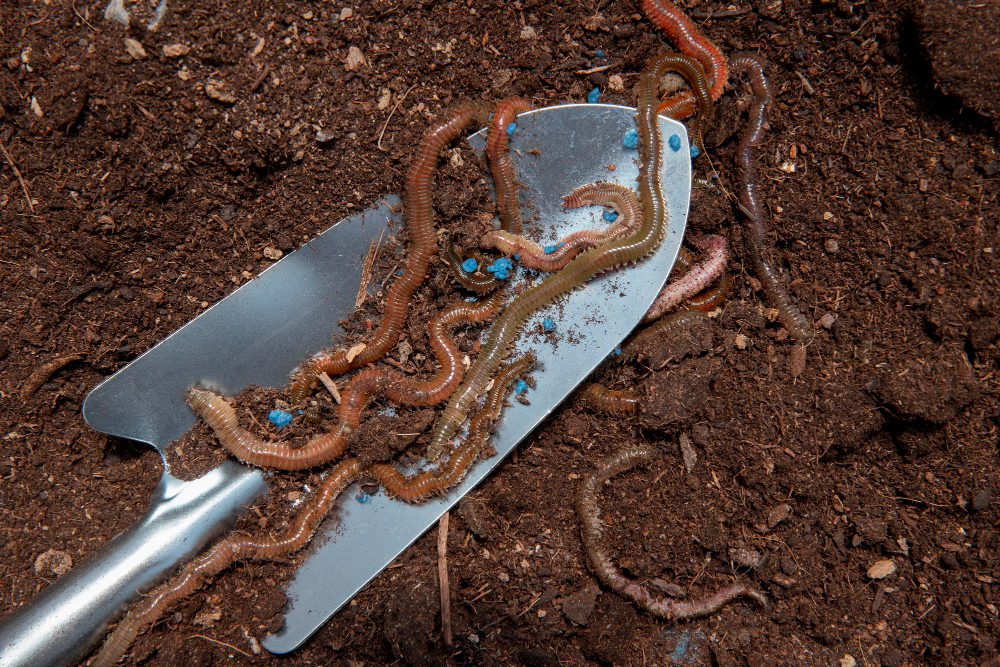Last updated on
In an era where environmental sustainability has become a critical concern, individuals around the globe are seeking innovative ways to contribute to a healthier planet. The practice of worm farming is emerging as a key player in environmental conservation efforts, offering a simple yet effective solution to several pressing environmental issues.
With that in mind, this article will shed light on the environmental advantages of initiating a worm farm within the comfort of your home.
What Is a Worm Farm?

A worm farm, also known as a vermicomposting system, is a sustainable method of recycling organic waste using the natural digestion process of worms. This innovative approach to composting involves housing worms in a controlled environment where they feed on kitchen scraps, yard waste, and other biodegradable materials.
As the worms consume this organic matter, they break it down and produce vermicast, also known as worm castings, which is a nutrient-rich, natural fertilizer highly beneficial for soil health and plant growth. Utilizing various types of worm farms offers a green approach to managing waste, significantly reducing the amount of organic material that ends up in landfills.
Types of Worms Used in Worm Farming
In worm farming, not all worms are created equal. Certain species are better suited for the task due to their ability to thrive in confined spaces and their efficiency in processing organic waste. Here are the primary types of worms used in worm farming:
- Red Wigglers (Eisenia fetida)
Red Wigglers are the most popular choice for worm farming. They are known for their voracious appetite, making them highly efficient at converting kitchen scraps, yard waste, and other organic materials into nutrient-rich compost.
These worms are well-adapted to the bin environment and can tolerate a wide range of temperatures, although they prefer conditions between 55°F and 77°F (13°C to 25°C). Their prolific breeding rate and ability to live in densely populated make them ideal for small-scale and home-based worm farms.
- European Nightcrawlers (Eisenia hortensis)
European Nightcrawlers are another variety often used in composting at home. Slightly larger than Red Wigglers, they are also effective composters and can handle a similar diet. European Nightcrawlers are particularly valued for their larger size, which makes them suitable for fishing bait and composting. They thrive in similar conditions to Red Wigglers and can also be kept in dense populations, making them a versatile choice for worm farming.
- African Nightcrawlers (Eudrilus eugeniae)
African Nightcrawlers are favored in warmer climates, as they require higher temperatures to thrive compared to Red Wigglers and European Nightcrawlers. They are efficient composters and can grow to be quite large, which also makes them desirable as fishing bait. However, their sensitivity to cold temperatures limits their use to regions with warm, consistent climates or environments where temperature control is feasible.
- Blue Worms (Perionyx excavatus)
Blue Worms are known for their rapid composting abilities and are well-suited to tropical climates. They are highly active and reproduce quickly, making them an excellent choice for accelerating the composting process. However, they are more sensitive to environmental changes and can be more challenging to manage than Red Wigglers or European Nightcrawlers.
How to Start a Worm Farm at Home

Starting a worm farm at home is a rewarding endeavor that contributes to waste reduction and soil enrichment. Here’s a detailed guide on how to establish your worm farm:
Step 1: Select a Bin
Choose a shallow container with ventilation and drainage holes. Commercial bins or DIY options from plastic or wooden materials work well.
Step 2: Prepare Bedding
Use moistened shredded newspaper, cardboard, or coconut coir to fill the bin, leaving space at the top.
Step 3: Add Worms
Introduce about 1,000 Red Wigglers (or 1 pound) into the bin, the preferred species for their efficiency.
Step 4: Feed Your Worms
Start with small amounts of fruit and vegetable scraps, avoiding meat, dairy, and citrus. Increase food volume as worms process waste.
Step 5: Maintain Your Farm
Keep bedding moist and the bin at a temperature between 55°F and 77°F. Monitor and adjust as needed.
Step 6: Harvest Vermicompost
After 3-6 months, separate worms from compost by adding fresh bedding and food to one side of the bin, then collect the compost from the other.
Environmental Benefits of Worm Farming
Worm farming offers many environmental benefits, making it an invaluable practice for sustainable living. Here are some of its many advantages:
- Waste Reduction: By composting food scraps and yard waste, worm farming helps divert waste from landfill sites, where it would otherwise decompose anaerobically, producing methane, a potent greenhouse gas.
- Soil Health Improvement: The vermicompost produced by worms is an excellent soil conditioner. It enriches the soil with essential nutrients and beneficial microorganisms, improving soil structure, aeration, and water retention.
- Reduction Of Greenhouse Gas Emissions: By decomposing organic waste aerobically, worm farming reduces the production of methane gas that would have been generated if the waste decomposed anaerobically in landfills.
- Sustainable Agriculture: Vermicompost helps maintain the ecological balance by encouraging the growth of beneficial microbes in the soil, which support plant growth and health.
- Water Conservation: The use of vermicompost improves soil structure, which enhances its water-holding capacity. This means that plants require less water, thus conserving water resources.
- Reduced Use of Chemicals: By providing a natural alternative to chemical fertilizers and pesticides, worm farming helps reduce the reliance on these substances, which can be harmful to the environment and human health.
The Takeaway
The environmental benefits of starting a worm farm at home extend far beyond the immediate vicinity of one’s garden. They contribute to a more significant movement towards sustainability, highlighting how small-scale, individual actions can collectively make a substantial impact on the planet’s health.
Related reading:
Table of Contents





